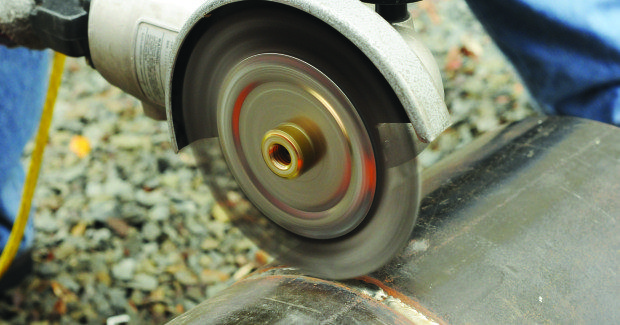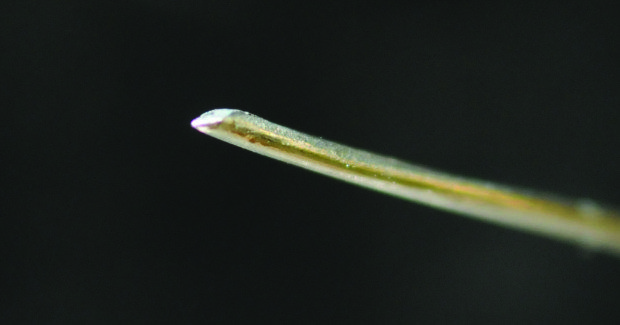New Weld Brushes Make Flipping Easy
Thanks to new technology that increases wire life and operator safety as the brush wears, flipping your wire brush during surface cleaning has never been easier.
Posted: April 15, 2015
In inter-pass and post-weld surface cleaning applications, the tips of a wire brush wear with normal use, which in turn reduces the cut rate of the brush over time. Because of this it has long been a common practice in the industry to occasionally take the brush off the grinder and flip it over to take advantage of the self-sharpening of the wire tips for maximum brush performance. However, the design of brushes with a nut on only one side can lead to problems with the side-plate hitting the guard or housing on the tool. This design also may make it more likely that the operator will remove the guard to flip the brush, impacting safety.
One new brush technology helps solve those problems. Some weld cleaning brushes are designed with a dual-hex nut that allows for easy flipping of the wheel and elimination of interference issues that pose a safety hazard for operators. The dual-hex nut design makes it quicker, safer and easier to flip the brush, so operators can gain the advantages of optimized performance and longer brush life.
BRUSH FLIPPING TECHNOLOGY
Operators who work frequently with wire brushes realize quickly that periodically flipping the brush helps keep the wire tips sharp for more effective cleaning action. This means the operator doesn’t have to push as hard or exert as much effort to clean the weld. Because the grinder rotates in one direction, the wire tips become dull in that direction with use. As the tips wear, the operator may have a tendency to push harder in order to accomplish sufficient cleaning action. Making it easier and faster to flip the brush allows the operator to use the other side of the wire tips, which become razor-sharp as the opposite side wears.
However, with the previous single-nut brush design it was not as easy or convenient to flip the brush, so operators had a tendency to remove the guard in order to accomplish it. Removing the guard leads to issues regarding operator safety, and not flipping the brush as often — or at all — results in less effective cleaning action that impacts operator fatigue and safety and brush productivity.
A new brush technology makes flipping the brush easier, to help maximize wire life and operator safety as the product wears. The design of these newer brushes features a hex on each side of the wheel and adequate tool clearance, so the wheel position can be changed without removing the guard from the tool. A brush that can be easily flipped or reversed provides numerous advantages. Because a dull brush is less effective, easy flipping means having a more efficient cleaning tool, so the operator doesn’t have to work as hard to get results. This improves operator safety and brush productivity, and it can impact savings and the return on investment of the tools.
This brush design is ideal for pipe welding applications, both in the shop and the field. It’s best used in open areas where the hex nut would not come into contact with another surface. Tight angles, particularly with brushes of a smaller diameter such as 4.5 in or 5 in, are not the best fit for this brush design. A 45 deg angle work area, for example, doesn’t have much depth of reach for the wire, and the nut could potentially get in the way in those applications.
SAFETY BENEFITS
Applying too much pressure to a brush is a common and problematic mistake that raises safety concerns. With a dull brush, the operator expends more effort and therefore becomes more fatigued, which in turn impacts safety and productivity. It also presents additional safety concerns when an operator who is working out of position tries to push or force a tool harder than necessary, which can create an even more unfavorable or uncomfortable position for the operator. The more pressure an operator exerts, the more chance there is for them to slip.
In addition to the safety issues, applying excessive pressure to the brush causes over-bending of the filaments and heat buildup, two factors that can result in filament breakage. Flipping the brush frequently helps keep the wire tips sharp, reducing the need for the operator to push hard or exert more pressure. This benefits operator safety and helps reduce fatigue.
IMPROVED PRODUCTIVITY
Along with the operator safety benefits, this brush technology also benefits productivity. A brush with sharper tips provides more efficient and effective cleaning action of the weld. Sharp wire points will bite into the weld and get into nooks and crannies much easier. The result is faster, more effective cleaning action that doesn’t require the operator to push as hard to get the job done. Having a brush that is easier and faster to flip also benefits productivity by extending product life. Frequently flipping the brush means the product will last longer, since an operator tends to push harder on a dull brush, which breaks down the wires and is detrimental to brush life.
Choosing a brush with the dual-hex nut technology typically offers a faster return on investment, since this type of brush offers longer product life compared to a brush that is not designed to flip easily. The more efficient cleaning action also contributes to a faster ROI, through labor savings and avoiding rework on welds that are not sufficiently cleaned.
CONSIDER BRUSH QUALITY
In addition to brush design, it’s also important to consider the quality of the brush and how it was manufactured when selecting a product for weld cleaning. Look for products that utilize heat-treated, high-tensile wire and are designed for low vibration. These products typically offer a greater ROI because they can be more effective and last longer. Some manufacturers also offer various face widths in this brush design. A thicker, wider face-width product can offer more effective cleaning in some applications. A brush with a wider face is designed to clean a wider surface area and can be helpful on large diameter heavy-wall pipe, for example.
It’s important to choose the right tool for the application to achieve the greatest efficiency. Periodic flipping can improve safety and productivity. Welders want to complete inter-pass and post-weld cleaning quickly, efficiently and safely so they can get back to the welding process. New technology that allows for easy flipping of the brush reduces the need for operators to apply too much pressure, an especially important safety consideration when working out of position. This helps makes operators safer in field applications.
This brush technology also helps improve productivity by promoting more efficient cleaning action and extending product life.













